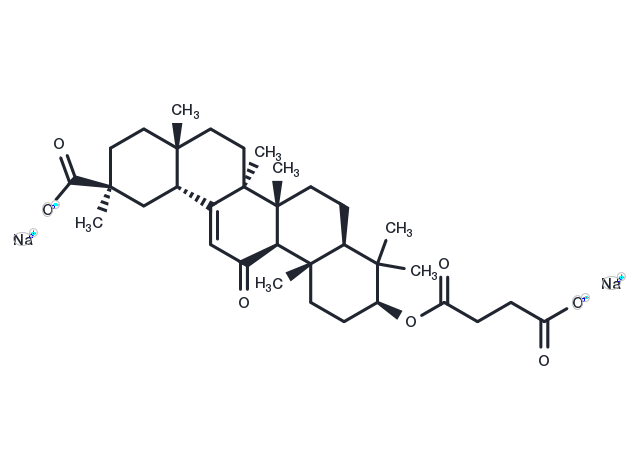Powder: -20°C for 3 years | In solvent: -80°C for 1 year


Carbenoxolone disodium (Duogastrone) salt is an agent derived from licorice root. It is used for the treatment of digestive tract ulcers, especially in the stomach. Antidiuretic side effects are frequent, but otherwise, the drug is low in toxicity.

| Pack Size | Availability | Price/USD | Quantity |
|---|---|---|---|
| 5 mg | In stock | $ 32.00 | |
| 10 mg | In stock | $ 43.00 | |
| 25 mg | In stock | $ 66.00 | |
| 50 mg | In stock | $ 97.00 | |
| 100 mg | In stock | $ 166.00 | |
| 500 mg | In stock | $ 397.00 | |
| 1 mL * 10 mM (in DMSO) | In stock | $ 57.00 |


| Description | Carbenoxolone disodium (Duogastrone) salt is an agent derived from licorice root. It is used for the treatment of digestive tract ulcers, especially in the stomach. Antidiuretic side effects are frequent, but otherwise, the drug is low in toxicity. |
| Synonyms | Biogastrone, Duogastrone, Bioral |
| Molecular Weight | 614.72 |
| Formula | C34H48Na2O7 |
| CAS No. | 7421-40-1 |
Powder: -20°C for 3 years | In solvent: -80°C for 1 year
H2O: 162.7 mM
DMSO: 37.4 mM
You can also refer to dose conversion for different animals. More
bottom
Please see Inhibitor Handling Instructions for more frequently ask questions. Topics include: how to prepare stock solutions, how to store products, and cautions on cell-based assays & animal experiments, etc.
Carbenoxolone disodium 7421-40-1 Cytoskeletal Signaling Gap Junction Protein Inhibitor derivative VACV esophageal Orthopoxvirus oral ulceration Carbenoxolone peptic Biogastrone ?anticonvulsant Duogastrone inhibit muscle relaxant Vaccinia virus acid hypnotic Bioral inflammation,?cream glycyrrhetinic inhibitor
